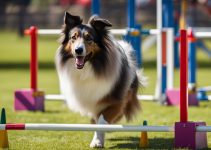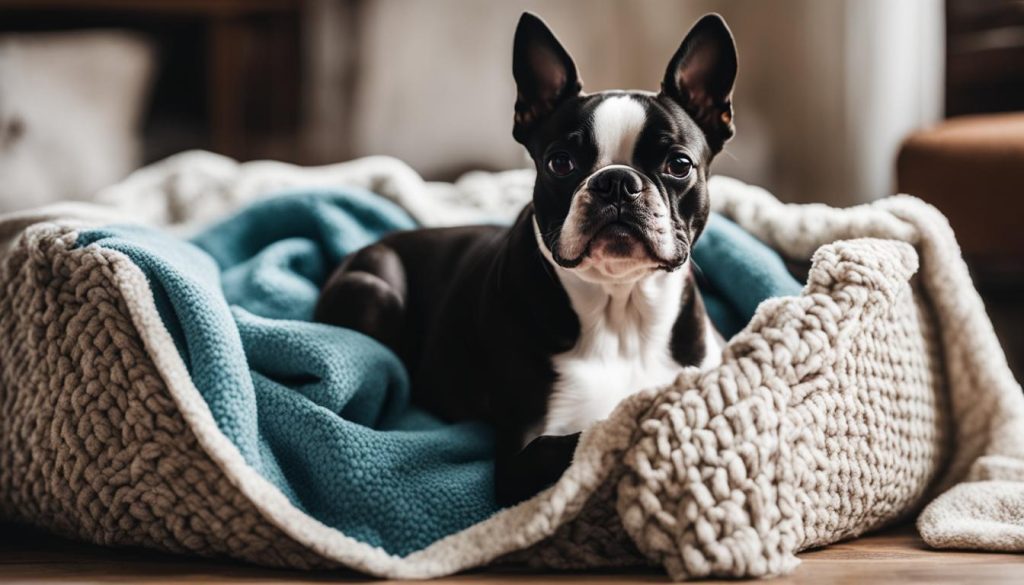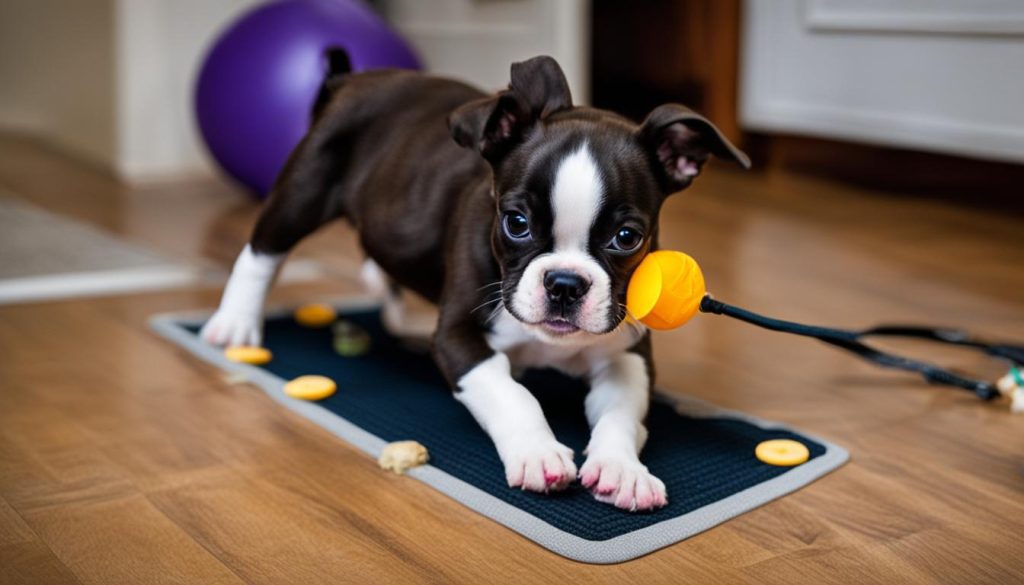Welcome to my guide on Boston Terrier training! If you’re a proud owner of this adorable breed, you know that training is essential to ensure a happy and well-behaved companion. In this article, I will share with you some of the best Boston Terrier training tips to help you establish a strong bond with your furry friend. Whether you’re looking to crate train, house train, or teach commands, these tips will set you on the path to success.
One of the key aspects of Boston Terrier training is crate training. A properly sized crate, comfortable bedding, and enticing chew toys can create a safe and cozy space for your dog. With patience and positive reinforcement, you can gradually introduce your Boston Terrier to the crate and make it a place where they feel secure.
House training is another vital aspect of training your Boston Terrier. By establishing a regular bathroom schedule, confining your dog to a designated area, and using positive reinforcement, you can help them understand where it’s appropriate to eliminate.
Teaching commands to your Boston Terrier is not only enjoyable but also necessary for their well-being. By using positive reinforcement techniques such as treats and verbal praise, you can easily train your Boston Terrier to follow commands and behave appropriately.
Behavior problems can arise in any dog, but with the right training methods, you can address and correct them effectively. From chewing to barking, understanding your Boston Terrier’s body language and communication cues will enable you to communicate more effectively and establish yourself as the pack leader.
Remember, training your Boston Terrier requires patience, consistency, and a positive attitude. By following these training tips, you can provide the best environment for your furry friend to thrive. Let’s dive in and unlock the joy of Boston Terrier training!
Unraveling Boston Terrier Training
- Proper crate training is essential for a comfortable and secure space for your Boston Terrier.
- Establishing a regular bathroom schedule and using positive reinforcement aids in house training.
- Positive reinforcement, short training sessions, and a positive tone of voice are crucial for teaching commands.
- Understanding your Boston Terrier’s body language and communication cues helps address behavior problems effectively.
- Consistency, patience, and a positive attitude are key to successful Boston Terrier training.
Crate Training Your Boston Terrier
Crate training is an essential component of effective training methods for Boston Terriers. Not only does it aid in house training, but it also provides a safe and comfortable space for your furry friend. By following top training techniques for Boston Terriers and using positive reinforcement, you can make crate training a positive and rewarding experience.
To begin crate training, it is crucial to choose the right-sized crate for your Boston Terrier. A crate measuring 24 x 30 inches or 24 x 36 inches is usually suitable. Make the crate cozy by adding comfortable bedding and some favorite toys. This will help create a positive association with the crate.
One of the most effective ways to introduce your Boston Terrier to the crate is through food. Lure your dog inside the crate using treats and rewards. Encourage your dog to enter the crate willingly and praise him for doing so. This positive reinforcement training for Boston Terriers will help your pup associate the crate with positive experiences.
As your Boston Terrier becomes comfortable with the crate, gradually introduce commands. Use simple phrases like “crate” or “go to bed” and reward your dog every time he follows the command and enters the crate. This reinforcement helps reinforce the desired behavior.
Start crate training sessions by crating your Boston Terrier for short periods, gradually increasing the duration over time. Allow your dog to get used to spending time in the crate without feeling anxious or confined. This gradual approach helps prevent separation anxiety and destructive behavior.
Remember to make the crate a positive and inviting space for your Boston Terrier. Never use the crate as a form of punishment, as this can create negative associations and hinder the training process. Instead, make it a cozy retreat by adding a blanket or a familiar-smelling item.
Crate training your Boston Terrier using effective training methods and positive reinforcement techniques can contribute to a well-behaved and happy companion. It provides your dog with a sense of security and helps establish boundaries. With patience and consistency, your Boston Terrier will learn to love their crate and see it as their own special place within your home.
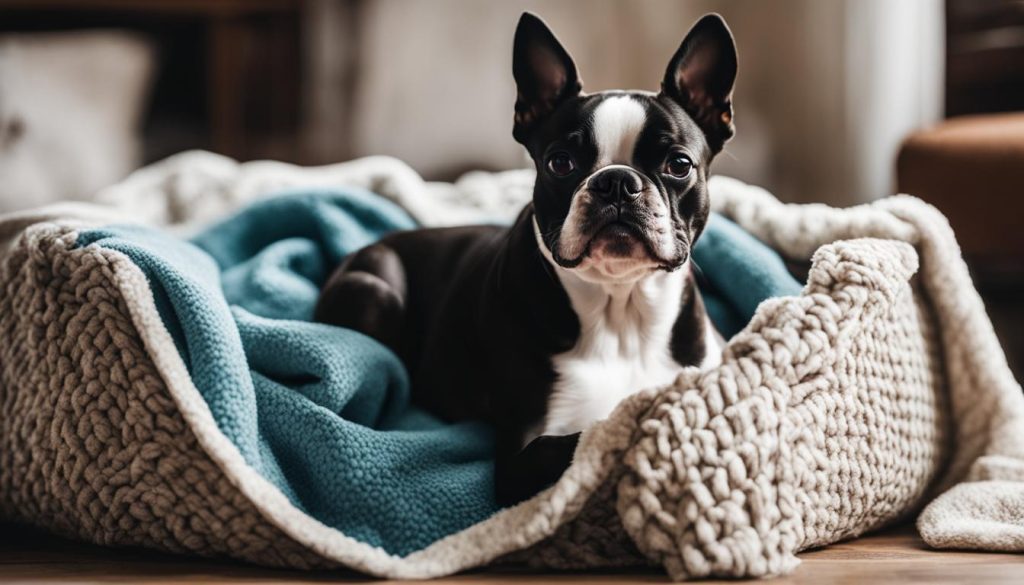
House Training Your Boston Terrier
When it comes to Boston Terrier training, house training is a crucial aspect that requires early attention. By establishing good habits from the start, you can create a clean and comfortable living environment for both you and your furry friend.
To begin house training, it’s important to confine your Boston Terrier to a small area or use baby gates to create a designated bathroom spot. This helps establish boundaries and reduces the chances of accidents occurring throughout your home.
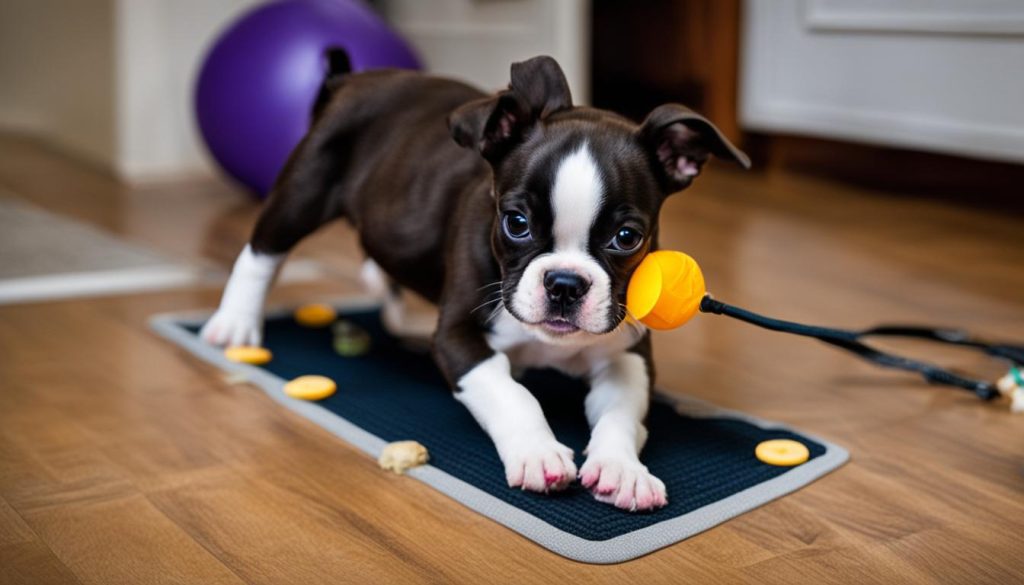
Creating a regular bathroom schedule is essential. Take your Boston Terrier outside after meals, naps, drinking water, and playtime. This routine will help your dog become familiar with the outdoor bathroom spot and develop a consistent bathroom routine.
Using a leash during outdoor bathroom breaks ensures that your Boston Terrier stays focused and eliminates in the proper spot. Remember to reward your dog with praise or treats when they successfully eliminate in the designated area. This positive reinforcement helps reinforce proper behavior.
If accidents do occur inside your home, it’s important not to punish your Boston Terrier. Instead, clean up the mess promptly and thoroughly with an enzymatic cleaner to eliminate any lingering odors. Punishment can create fear and confusion, making it more difficult for your dog to understand and follow the house training process.
Lastly, avoid the outdated and ineffective practice of rubbing your Boston Terrier’s face in urine or feces. This approach is not only unnecessary but can also lead to negative associations and poor training outcomes.
By following these effective Boston Terrier training techniques, such as establishing a bathroom schedule, using a leash, and avoiding punishment, you can successfully house train your Boston Terrier and create a comfortable living environment for both you and your furry friend.
Teaching Commands to Your Boston Terrier
When it comes to obedience training for your Boston Terrier, teaching commands is an essential part of the process. By effectively communicating with your dog and providing consistent training, you can ensure that your furry friend becomes a well-behaved and obedient companion. Here are some tips and techniques to help you with teaching commands to your Boston Terrier.
Focus on One Command at a Time
To prevent confusion, it’s important to focus on teaching one command at a time. This allows your Boston Terrier to fully understand and grasp each command before moving on to the next one. Start with basic commands such as “sit”, “stay”, and “come”. Once your dog has mastered these commands, you can gradually introduce more advanced commands.
Limit Repetitions and Keep Training Sessions Short
When teaching commands to your Boston Terrier, it’s important to limit the number of repetitions for each command. This prevents your dog from becoming bored or overwhelmed. Additionally, keeping training sessions short helps maintain your dog’s focus and prevents frustration. Aim for training sessions that are around 10-15 minutes long, multiple times a day.
Use Positive Reinforcement
Positive reinforcement is a highly effective training method for Boston Terriers. Reward your dog with treats and verbal praise whenever they successfully follow a command. This positive association reinforces the desired behavior and motivates your dog to continue obeying commands. Remember to use a positive tone of voice and avoid shouting or raising your voice, as it can create a negative environment.
Train Indoors During Extreme Weather
Extreme weather conditions can make outdoor training challenging. During hot summers or cold winters, it’s best to train your Boston Terrier indoors. Find a spacious area in your home where you can focus on teaching commands without any distractions. Be sure to create a positive and comfortable environment for your dog to enhance the training experience.
Enroll in Obedience Classes
If you feel like you need additional guidance and support, enrolling your Boston Terrier in obedience classes can be highly beneficial. Training classes provide a structured environment with professional trainers who can help you fine-tune your training techniques and address specific behavioral issues. These classes also offer opportunities for socialization, which is essential for a well-rounded and well-behaved dog.
By following these tips and techniques, you can successfully teach commands to your Boston Terrier and foster a strong bond based on trust and obedience. Remember to be patient, consistent, and always prioritize positive reinforcement. Boston Terriers thrive on love and attention, and with the right training methods, you can raise a happy and well-behaved companion.
Solving Behavior Problems
Addressing behavior problems is an essential part of Boston Terrier training. Common issues like chewing, barking, jumping, and begging can be corrected with the right approach. One effective method is positive reinforcement, rewarding good behavior to encourage repetition. Consistency is crucial in training to establish expectations and boundaries for your Boston Terrier.
To effectively address behavior problems, it’s important to understand your Boston Terrier’s body language and vocal cues. By paying attention to their signals, you can identify triggers and address the root causes of their unwanted behaviors.
If you’re facing challenges in solving behavior problems on your own, seeking professional help can be beneficial. Private lessons or group obedience classes with experienced trainers can provide expert guidance tailored to your Boston Terrier’s specific needs. You can also explore online resources and communities that offer valuable insights and advice.
In addition to addressing behavior problems, it’s important to establish yourself as the leader in your Boston Terrier’s eyes. Effective communication and consistent training techniques will help your dog learn to respect you and follow your commands.
By addressing behavior problems with positive reinforcement, seeking professional help if needed, and establishing a strong leadership role, you can effectively train your Boston Terrier and foster a harmonious bond.
Conclusion
Boston Terrier training is crucial for cultivating a well-behaved and happy companion. Whether it’s crate training, house training, or teaching commands, implementing effective training techniques is essential. By using positive reinforcement, short training sessions, and maintaining a positive tone of voice, you can foster a strong bond and instill good behavior in your Boston Terrier.
While you may encounter challenges along the way, remember to be patient and consistent with your training efforts. It’s important to seek professional help, such as training classes, if you need additional guidance. Don’t underestimate the power of consistency and the impact it can have on your Boston Terrier’s behavior.
By following these training tips and techniques, you can unlock the joy of Boston Terrier training and witness the transformation of your furry friend. Embrace the process, enjoy the journey, and revel in the rewards of a well-trained and happy Boston Terrier.
FAQ
Why is crate training important for Boston Terriers?
Crate training is important for Boston Terriers because it provides them with a safe and comfortable space, helps prevent destructive behavior and separation anxiety, and aids in house training.
How do I choose the right-sized crate for my Boston Terrier?
The right-sized crate for a Boston Terrier is usually around 24 x 30 inches or 24 x 36 inches. It should be large enough for your dog to stand, turn around, and lie down comfortably.
How do I crate train my Boston Terrier?
To crate train your Boston Terrier, make the crate comfortable with bedding and toys, lure your dog inside with food, and gradually increase the duration of time spent in the crate.
When should I start house training my Boston Terrier?
It is best to start house training your Boston Terrier as early as possible. Establish a regular bathroom schedule, confine your dog to a small area or use baby gates, and take your dog outside after meals, naps, and playtime.
How can I teach commands to my Boston Terrier?
To teach commands to your Boston Terrier, start with one command at a time, limit repetitions, use positive reinforcement with treats and verbal praise, and keep training sessions short.
What can I do to solve behavior problems in my Boston Terrier?
To solve behavior problems in your Boston Terrier, use positive reinforcement and consistent training methods, focus on understanding your dog’s body language and vocal cues, and seek professional help if needed.

